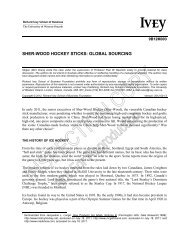foundation of canada asia pacific - Content Tagged with
foundation of canada asia pacific - Content Tagged with
foundation of canada asia pacific - Content Tagged with
Create successful ePaper yourself
Turn your PDF publications into a flip-book with our unique Google optimized e-Paper software.
The largest pool <strong>of</strong> investable Canadian funds, the more than $1.3 trillion held in<br />
various retirement savings schemes for Canadian workers, are mostly unavailable to support<br />
Canadian investment in Asia. 3 Under the foreign property rule <strong>of</strong> the Income Tax Act, no<br />
more than 25% (rising to 30% in 2001) <strong>of</strong> funds held in tax-deferred pension savings<br />
vehicles can be invested in foreign assets, and few institutions look beyond the US in<br />
placing funds <strong>of</strong>fshore. One small, though notable, exception to this is the investment by<br />
Quebec’s Caisse de dépôt et placement du Québec <strong>of</strong> $200 million, jointly <strong>with</strong> the Asian<br />
Development Bank, in an Asian Infrastructure Fund to take advantage <strong>of</strong> the estimated<br />
US $10 trillion 4 <strong>of</strong> very long-term funding needed to support infrastructure<br />
development in Asia over the next 30 years. However, this is far from a typical strategy for<br />
a Canadian institution. Economists Joel Fried and Ron Wirick have argued in a recent<br />
C.D. Howe Institute study 5 that the restriction on foreign investment has depressed<br />
the return to Canadians on their retirement savings by up to $4 billion a year. It has also<br />
deprived Canadian companies <strong>of</strong> access to funds that could support greater investment in<br />
Asia. Canada’s restriction on pension fund investment bucks a trend elsewhere in the<br />
world where foreign holdings by pension funds are rising rapidly. Figures quoted by Fried<br />
and Wirick show that foreign assets as a proportion <strong>of</strong> world pension assets rose from<br />
8.2% in 1992 to 13.2% in 1997 and are projected to climb to 16.7% by 2002.<br />
15<br />
Policies involving such things as the pension savings <strong>of</strong> Canadians may appear to be entirely<br />
domestic in their focus. However, the globalization <strong>of</strong> financial markets means that in an<br />
open economy such as ours, all major financial policies will have an impact on our<br />
international position. In this case, relaxation or removal <strong>of</strong> the restriction on pension<br />
fund investment would likely boost Canadian corporate investment <strong>of</strong>fshore. The increased<br />
force driving trade liberalization. This movement gained an added boost at the end <strong>of</strong> the 1980s <strong>with</strong><br />
the collapse <strong>of</strong> the communist bloc and the adoption <strong>of</strong> “market-driven” economies by its former<br />
members. China’s pending membership <strong>of</strong> WTO will mark the end <strong>of</strong> any significant international<br />
trade outside the rules <strong>of</strong> this body. With China a member, 136 countries out <strong>of</strong> the 188 that are<br />
members <strong>of</strong> the United Nations will be parties to WTO.<br />
A further development driving globalization, especially in Asia, was the doubling in the value <strong>of</strong> the<br />
yen as a result <strong>of</strong> the 1985 Plaza Accord reached between major trading nations. To maintain its export<br />
competitiveness, Japanese industry invested massively in Southeast Asia, building <strong>of</strong>fshore plants to<br />
supply not only third-country markets, but its domestic market as well. This huge inflow <strong>of</strong> Japanese<br />
capital encouraged the development <strong>of</strong> a network <strong>of</strong> industries straddling borders, and producing<br />
Japanese products bearing “Made in Thailand” or “Made in Malaysia” labels, and assembled from<br />
parts made in two or three neighbouring countries.<br />
While globalization has had a marked impact on economic efficiency worldwide, many people charge<br />
that this comes at the price <strong>of</strong> a weakening <strong>of</strong> national sovereignty, and that countries have to yield<br />
effective control over some areas <strong>of</strong> domestic policy if they wish to remain competitive in the global<br />
economy. In some areas this is clearly true, and it is explicit. For example, governments that opt to join<br />
the WTO have an obligation to adhere to its restrictions on supporting certain industries. However,<br />
the loss <strong>of</strong> freedom <strong>of</strong> action tends to be in areas that impinge on economic efficiency. Governments<br />
that join WTO believe there is a net gain to them and their people if they accept a greater market<br />
discipline. China, a country jealous <strong>of</strong> its sovereignty and powerful enough to set its own rules, faced<br />
up to this choice. It decided that the benefits <strong>of</strong> WTO membership justified the loss <strong>of</strong> sovereignty



